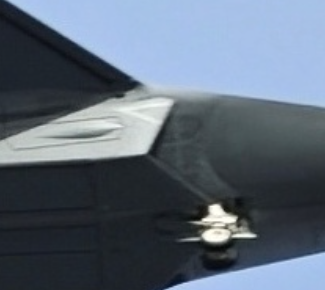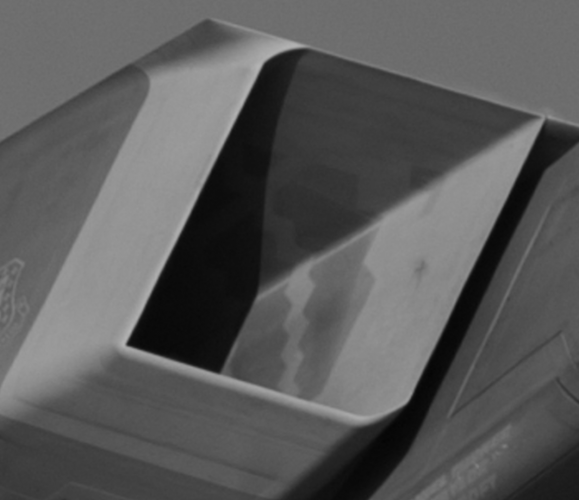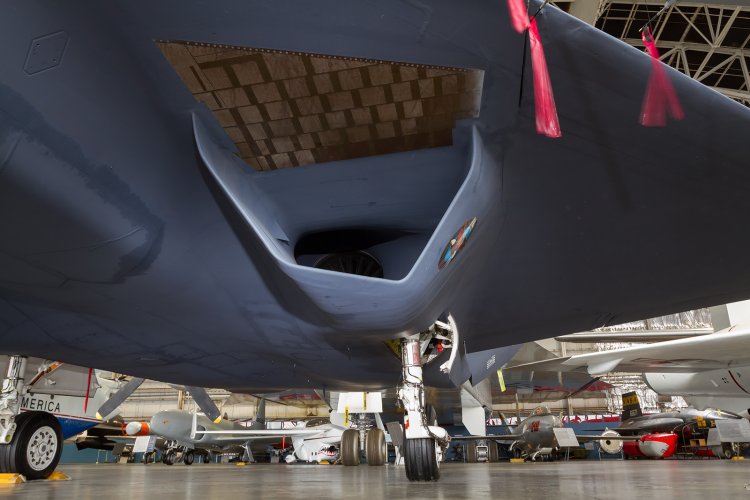You are using an out of date browser. It may not display this or other websites correctly.
You should upgrade or use an alternative browser.
You should upgrade or use an alternative browser.
Shenyang / Chengdu "6th Gen" Aircraft - News and Analysis
- Thread starter tequilashooter
- Start date
- Joined
- 2 August 2006
- Messages
- 3,255
- Reaction score
- 1,527
My guess is the serrated edge bay is an actual weapons bay for testing and the other bay is probably being used for flight test equipment. Production aircraft would revert to having both as weapons bays.I noticed the starboard ventral weapons bay has a sawtooth edge, but not the port side. Software or lens distortion?
- Joined
- 27 December 2005
- Messages
- 17,727
- Reaction score
- 26,265
Or its an AI scaling artifact.My guess is the serrated edge bay is an actual weapons bay for testing and the other bay is probably being used for flight test equipment. Production aircraft would revert to having both as weapons bays.
If it really is as your plan shows, it's a pretty smart space-saving solution.Short-range missile placement option
Scott Kenny
ACCESS: USAP
- Joined
- 15 May 2023
- Messages
- 11,513
- Reaction score
- 14,080
Reloading that may not be fun if the bay doesn't have a trapeze, but it definitely works.Short-range missile placement option
They miscalculated the length of the missile, so they had to add a bulge to fit? I doubt it. Internal gun there might be a better guess, but it looks like there is not enough space with the wheel retracted. Or is it? I'd say this is probably some kind of ECM/RWR antenna, datalink maybe or something like that.Short-range missile placement option
- Joined
- 21 April 2009
- Messages
- 13,739
- Reaction score
- 7,649
I’m no aerodynamicist but don’t really think you can compare birds to aircraft at all in this particular way.A lot of manoeuvring in birds and bats is done through wing tip deflection, with the tail being used more often in a role similar to that of flaps (trim and lift control). There are exceptions of course, here you can see the tail being used sometimes to deal with a cross-wind:View: https://www.youtube.com/watch?v=iJff3J_9jVs
Overall though tails are flat (i.e. oriented like a horizontal stabiliser) and integrated into the trailing edge of the wing. So, they'd be classified as tailless design with some polymorphic abilities.
It is worth noting that long tailed versions of birds, bats, and pterosaurs are all well documented, but they were eventually replaced by tailless lineages.
Not directly comparable to aircraft, but I wouldn't be surprised if there isn't a reason for this that also applies to some types of aircraft in the future. Look at the amount of weight the active controls the Boeing Spanloaders would have required in the 1970s, now look at the weight of modern computers and the ability to do things like have distributed airflow sensors... there are a lot of technological limitations against distributed lift designs which are increasingly being overcome.
The amount they can twist and bend and flex their wings in flight is outside any comparison to rigid wings and flaps, etc. IMO.
The K2
ACCESS: Secret
- Joined
- 29 June 2020
- Messages
- 303
- Reaction score
- 682
I have to agree. Not enough space for a missile without making it a contortion act. Was looking at photos of the J-31 and J-35, no side weapons bays. It seems Shenyang stays away from them (at least for now).They miscalculated the length of the missile, so they had to add a bulge to fit? I doubt it. Internal gun there might be a better guess, but it looks like there is not enough space with the wheel retracted. Or is it? I'd say this is probably some kind of ECM/RWR antenna, datalink maybe or something like that.
Last edited:
Scott Kenny
ACCESS: USAP
- Joined
- 15 May 2023
- Messages
- 11,513
- Reaction score
- 14,080
And I'd honestly expect 6th generation aircraft to very rarely carry short range AAMs, designing bays around BVRAAMs that are roughly AMRAAM sized.I have to agree. Not enough space for a missile without making it a contortion act. Was looking at photos of the J-31 and J-35, no side weapons bays. It seems Shenyang stays away from them (at least for now).

New Views Of China's Next Generation Fighters
We are seeing increasingly detailed imagery of Beijing's two new stealth fighter designs as other potential curious fighter-like objects have emerged out of China.
Regards,
Plus current practice from Ukraine, Israel or the Red Sea. SRAAMs are used to destroy small targets. And in the future, the sky will be teeming with small targets.So I'm confused.
Why do next generation of fighters don't need to carry WVR missiles?
Given they are stealth, tracking and even detecting them(using x band) at distances more than wvr will be hard.
Ainen
I really should change my personal text
- Joined
- 25 August 2011
- Messages
- 1,250
- Reaction score
- 1,670
SRAAMs, apart from their direct purpose, are the best shot at active self defense.And I'd honestly expect 6th generation aircraft to very rarely carry short range AAMs, designing bays around BVRAAMs that are roughly AMRAAM sized.
Much more suitable than MRAAMs.
For that they're too big an expensive still. This right now indeed rapidly emerges as the largest peacetime miscalculation of combat aviation.Plus current practice from Ukraine, Israel or the Red Sea. SRAAMs are used to destroy small targets. And in the future, the sky will be teeming with small targets.
Deployable FFAR-like pods for apkws seem to me to be the best and most achievable way.
mokahete
ACCESS: Restricted
- Joined
- 18 April 2025
- Messages
- 28
- Reaction score
- 12
Yeah small stealthy targets that will be hard to track at 30+ km even with large x band radars.Plus current practice from Ukraine, Israel or the Red Sea. SRAAMs are used to destroy small targets. And in the future, the sky will be teeming with small targets.
IRST/EOTS sensors can also be used, even if these subsonic small CCA emit way less heat than fighters, modern IR sensors should be able to track them at 40+km, given good environmental conditions and sun Is on your side.
Now BVR missiles will also be used
Especially when the main fighter jet is staying behind and using CCAs as sensor extenders.
But the importance of WVR missiles seems to be increasing, specially their insane kinematics.
because the plan is to have plenty of drones at the merge. so if WVR battles do happen, most are expected to be done by drones. This also address the stealth and tracking distances.So I'm confused.
Why do next generation of fighters don't need to carry WVR missiles?
Given they are stealth, tracking and even detecting them(using x band) at distances more than wvr will be hard.
also because MRAAM is quite lethal from short distances as well. Sure, it might be overkill sometimes and it might not always work as well as a SRAAM, but in most cases it'll still get the job done. All the while, the plane doesn't need to get configured to use such a class of missiles. Which is a small issue, but nevertheless.
Ainen
I really should change my personal text
- Joined
- 25 August 2011
- Messages
- 1,250
- Reaction score
- 1,670
I am still mildly looking forward to a moment, when someone will make an electric(hybrid) shahed on an automatic assembly line, shaped for no bullshit deep stealth without maintenance hatches at all.
No heat signature to speak of, radar signature several orders of magnitude below bird of prey.
Long range weapons...
No heat signature to speak of, radar signature several orders of magnitude below bird of prey.
Long range weapons...
Galaxy
ACCESS: Restricted
- Joined
- 14 December 2024
- Messages
- 49
- Reaction score
- 77
It’s unique, it probably also has an extremely small RCS, but from this angle it’s got to be the ugliest aircraft ever built.
To me it looks like it has B-2/YF-23 style exhaust system with engines further forward. I also can’t make out any canopy bow, I just see what looks like a HUD that might be mistaken for one? Can’t tell with the angle and resolution. That would be pretty impressive if they managed to create a single piece canopy given the size and the strength needed sustain high speed impact and stress.
Rhinocrates
ACCESS: Top Secret
- Joined
- 26 September 2006
- Messages
- 3,041
- Reaction score
- 7,688
it’s got to be the ugliest aircraft ever built
There is no excellent beauty that hath not some strangeness in the proportion.
Francis Bacon, Essays Civil and Moral, 'Of Beauty.'
Similar threads
-
-
Shenyang FC-31 demonstrators / J-35 naval fighter / J-35A land-based version
- Started by Foxglove
- Replies: 994
-
-
-
Chinese test of Fractional Orbital Bombardment System
- Started by Flyaway
- Replies: 100




